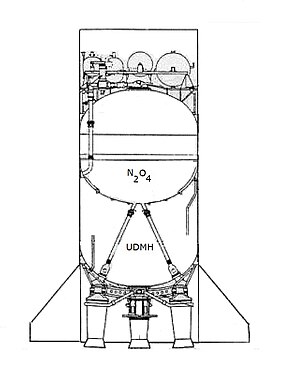|
Cora (rocket)
Cora was a French experimental rocket.[1] It was the largest rocket ever launched in Western Europe.[2] It was primarily used for testing the second (Coralie) and third stages (Astris) of the multinational Europa Rocket,[3][4] which was developed and produced by the European Launcher Development Organisation, the predecessor to the present day European Space Agency. For the Cora 1 only the French Coralie first stage was active. For the Cora 2 version the second German Astris stage was active. The Italian made Europa nose fairing was also tested.[3] ConfigurationThe entire rocket had a length of 11.5 metres, a diameter of 2.01 m and a takeoff weight of 16.5 tonnes. Total thrust was 220.00 kN, with the rocket capable of reaching an apogee of 55 km.[3] The Coralie first stage was 5.5 metres long and had a diameter of 2 metres; when fully fuelled, it weighed 9.85 tonnes; the propellant was a mixture of nitrogen tetroxide and unsymmetrical dimethylhydrazine (UDMH).[5] It was powered by a four-nozzle engine that produced 220 KN of thrust and had a specific impulse (in vacuum) of 280 seconds. A cylindrical black ring supporting four fins was attached to the rocket's base.[3] The Astris second stage was 3.36 meters long with a diameter of 2 meters; when fully fuelled, it weighed 3.370 tonnes; the propellant was a mixture of nitrogen tetroxide and Aerozine-50. It was powered by an engine that produced 23.33 kN of thrust and had a specific impulse (in vacuum) of 310 seconds.[6]
Launch historySix Cora launches were planned, the first four using the Cora 1 configuration and the last two using the Cora 2.[7] Only the three first launches took place, with the Cora 2 configuration never being tested:[7]
The following planned flights were cancelled and replaced by tests of the Europa rocket (Europa 1 F7, Europa 1 F6/1 and Europa 1 F6/2).[7] See alsoReferences
|
||||||||||||||||||||||||||||||||||||||||||||||||||||||||||


